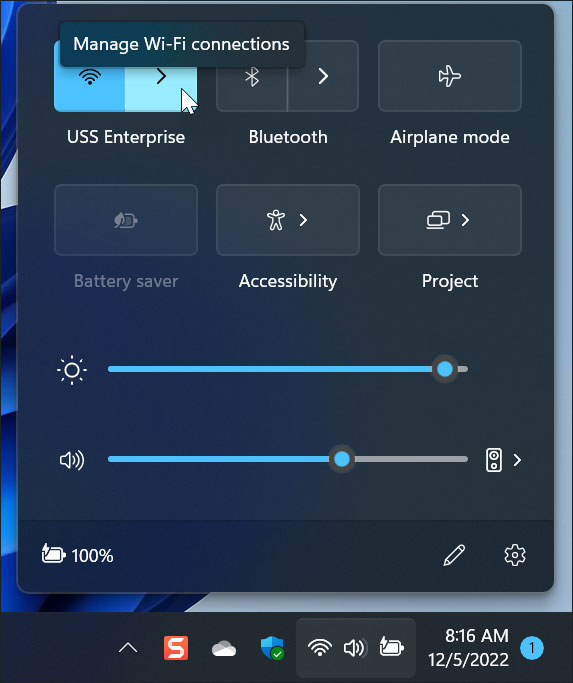|
In this issue WINDOWS 11: Is it time to move to Windows 11? Additional articles in the PLUS issue • Get Plus! ONENOTE: Getting everything you care about into OneNote FREEWARE SPOTLIGHT: Auto Recycle Bin — Honestly, it’s the only way I’ll remember OFFICE: Tame your tech: Office
WINDOWS 11 Is it time to move to Windows 11?
By Lance Whitney Microsoft is increasingly aiming its latest enhancements at Windows 11 instead of Windows 10. Does that mean it’s time to jump ship to the newest version of Windows? I’m in the market for a new primary laptop and face a choice of outfitting it with Windows 10 or Windows 11. A few months ago, I might have gone with Windows 10, but now I’m shooting for Windows 11. The irony is that I’ve been critical of Windows 11, specifically because of the dumbing down and inflexibility of the Start menu, Taskbar, and certain other features. So why am I opting for Windows 11? Windows 11 is still relatively young, having reached its first birthday this past October. But the new OS got off to a shaky start and still has a relatively small usage share (around 16% of all Windows PCs, according to the latest stats from StatCounter). In contrast, Windows 10 had already obtained almost a 30% share a year after its debut, again according to StatCounter. The slow uptake of Windows 11 isn’t hard to understand. First and foremost, the new OS imposes strict requirements for installation. To handle Windows 11, your PC needs a TPM 2.0 chip as well as Secure Boot enabled in the BIOS. The TPM demand in particular leaves many older PCs out of the running. But beyond these obstacles, Windows 11 changes certain core features, and not necessarily for the better. The new Start menu is a bare-bones affair, saddling you with a square, boxy layout with only pinned and recommended apps accessible right off the bat. Getting to all your installed apps requires a second step, an awkward maneuver to view what the Windows 10 Start menu shows you at first glance (Figure 1).
Further, the Windows 10 Start menu offers both an all-apps list and a tiled screen that you can easily customize with your favorite apps. Despite the appeal of that type of layout, Microsoft threw it out the window for Windows 11. In clobbering the traditional Start menu, Microsoft also removed such features as Live Tiles and folder creation. The recent Windows 11 22H2 update restored the folder creation feature, but Live Tiles remains persona non grata. The Taskbar is another element worse for the wear in Windows 11. In Windows 10, you can move the Taskbar to any side of the screen, change the height and size of the Taskbar, and decide whether to combine icons from the same apps. For reasons that seem mystifying, Microsoft removed the previous freedom and flexibility of the Taskbar for Windows 11. You can align it to the left or center of the screen and autohide the Taskbar, but that’s about it (Figure 2).
Another gripe I have about Windows 11 is that accessing certain features and settings requires a second step, compared with the behavior in Windows 10. Want to see all your apps in the Start menu? You have to click the Start button and then the All Apps button. Want to see all the available Wi-Fi networks from the System Tray? You have to click the Wi-Fi icon on the tray to display a Quick Settings window, and then click an arrow to display nearby networks (Figure 3).
On the plus side, Windows 11 does offer several benefits over its predecessor. The options for Snap Layouts and Snap Groups help you juggle and work with multiple apps and windows. The virtual desktop feature is easier to use than the one in Windows 10. The Widgets tool provides quick access to your customized news stories, weather, calendar, and more. Microsoft Teams is now baked into the operating system, so you can use it right off the bat to chat with other people — even if they don’t have a Teams account. For gamers, Windows 11 enhances the speed, performance, and compatibility of demanding PC games (Figure 4).
Plus, Microsoft recently enhanced Windows 11 with an update that included several new and improved features. Released in October, the Windows 11 22H2 update adds the ability to create Start menu folders, more layout choices for the Start menu, tabs in File Explorer, better OneDrive integration into File Explorer, Voice Access for dictating text and commands, and Microsoft’s Clipchamp for editing videos (Figure 5).
Still, why abandon the tried-and-true Windows 10 in favor of its successor? Part of the decision has to do with Microsoft itself. With the company now trying to push people toward its newer OS, most of the new and enhanced features popping up are now being directed at Windows 11 instead of Windows 10. You need only look at the 22H2 update for both operating systems. The update for Windows 11 brought with it a slew of improvements, some described above. The 22H2 update for Windows 10? Nada. A few bug fixes here and there, but no new features or enhancements to speak of. If you want to take advantage of the best and brightest ideas coming out of Microsoft’s Windows team, that means Windows 11. Of course, there’s also the issue of support. Windows 10 is due to lose Microsoft support come October 2025. After that point, you’ll no longer be able to get security updates and bug fixes or technical help for the OS. If you buy a new computer today, that you anticipate keeping for more than three years, and you want to ensure that it will continue to be protected against security threats, Windows 11 is the way to go. That’s certainly another reason why I’m getting Windows 11 on my next computer. Okay, but what about upgrading a current Windows 10 PC to Windows 11? Should you make the leap? Well, first you have to find out whether your PC is even capable. For that, you can run Microsoft’s PC Health Check Tool to discover whether your Windows 10 computer meets the strict requirements. If so, do you want to take advantage of the latest enhancements to Windows, which increasingly will appear in Windows 11 rather than 10? Or are the newest features of minimal value to you, and you’d rather stick with the comfort and familiarity of Windows 10? There’s no right answer. For me, the benefits of Windows 11 outweigh the drawbacks. So if I owned just one Windows computer that ran Windows 10, I’d most likely upgrade to Windows 11 at this point. But what about the downsides of Windows 11 that I mentioned? The dumbed-down Start menu. The inflexible Taskbar. Well, that’s where I rely on third-party utilities to come to my rescue. I’ve used Start menu alternatives to replace the built-in Start menu ever since Windows 8.1. With such programs as Start11, StartAllBack, and Open Shell, I’ve been able to use a traditional two-column Start menu through every incarnation of Windows from 8.1 to 10 to 11. And to surmount the limitations of the Windows 11 Taskbar, I take advantage of a utility called ExplorerPatcher, which lets me choose when and how to combine Taskbar buttons, change the size of the Taskbar icons, and move the Taskbar to any side of the screen. With these tools, I’m able to skirt past my major gripes with Windows 11, turning it into a more usable and friendly operating system. With Windows 10 support ending in three years, any new PC you buy should come with Windows 11, at least if you plan to keep the computer longer than that. But with Microsoft directing its newest features and improvements at Windows 11 and not Windows 10, upgrading an existing PC to the newer OS is also a move you should consider at this point.
Lance Whitney is a freelance technology reporter and former IT professional. He’s written for CNET, TechRepublic, PC Magazine, and other publications. He’s authored a book on Windows and another about LinkedIn.
The AskWoody Newsletters are published by AskWoody Tech LLC, Fresno, CA USA.
Your subscription:
Microsoft and Windows are registered trademarks of Microsoft Corporation. AskWoody, AskWoody.com, Windows Secrets Newsletter, WindowsSecrets.com, WinFind, Windows Gizmos, Security Baseline, Perimeter Scan, Wacky Web Week, the Windows Secrets Logo Design (W, S or road, and Star), and the slogan Everything Microsoft Forgot to Mention all are trademarks and service marks of AskWoody Tech LLC. All other marks are the trademarks or service marks of their respective owners. Copyright ©2022 AskWoody Tech LLC. All rights reserved. |
|||||||||||||||||||||||


















